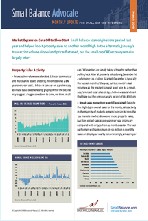Activity has remained quite robust for three years running, and solid demand has continued pushing recovery levels upward, and loss levels down, says David Tobin, principal with note-sale and property finance specialist Mission Capital. In fact as far as demand for small-balance NPLs is concerned, well-heeled distressed-debt specialists have to a great degree been squeezing out many of the local entrepreneurial types bidding at auction for one to three closely located assets, Tobin adds.
Home > MarketBeat
Home About Us Products MarketBeat News Online Shop Register
NPL Dispositions Slowdown? Not Really
August 16, 2012
Dispositions of sub and nonperforming commercial mortgages during 2012's first half were actually down notably from the yearearlier period: roughly $8.4 billion compared to $15.2 billion, according to advisor DebtX. But you'd never know it given the frantic pace ongoing at notesale specialists such as Auction.com, Mission Capital Advisors, Carlton Group, First Financial Network or DebtX for that matter.
As portfolio and securitized loans continue going into maturity and debtservice defaults at a pretty heady pace, debtholder representatives keep engaging disposition platforms and investors continue snapping it all up amid seemingly stronger demand than was seen during
2011's first half.
Indeed, activity has remained quite robust for three years running, and solid demand has continued pushing recovery levels upward, and loss levels down, says David Tobin, principal with notesale and property finance specialist Mission Capital. In fact as far as demand for smallbalance NPLs is concerned, wellheeled distresseddebt specialists have to a great degree been squeezing out many of the local entrepreneurial types bidding at auction for one to three closely located assets, Tobin adds.
As for the relative decline in aggregate volume for this year's first half, the corresponding 2011 period saw big banks (some of them offshore), CMBS special servicers and the FDIC bring several megaportfolios to market. With many moneycenter banks having taken
Favorable Expectations For 2014 Voiced By Experts in First Survey
After generating robust small
balance loan volume last year at
historically low interest rates, the question arises as to how the small commercial lending landscape is shaping up for
2014….![]()
SmallBalance Borrowers Go Long With Life Cos.
Property owners aiming to lock in today’s attractive rates over long
term holds are suddenly finding
plenty of interest among more aggressive life company lenders…
major steps to clean up portfolios, and with FDIC taking over far fewer failed institutions, it's now the regional and community banks that
have joined conduitloan special servicers to dominate the NPL disposition activity, Tobin explains.
And again, perhaps the most significant change in the smallbalance NPL arena is that the wellcapitalized specialists have shifted targets toward the $3 millionandunder category and in fact the sixfigure sector in many cases as well.![]()
More![]()
Read
As banks are quite active disposing of these smaller loans, they're a logical target for even the likes of powerhouses Colony Capital and Oaktree Capital. "With FDIC having taken its foot off the pedal, what we're seeing a lot of today isn't the $5 million and $10 million loans, it's banks offering loans with balances ranging from $250,000 to $3 million," Tobin notes. "And in fact a lot of them are less than $1 million."
This shift is also playing out in the pretty consistent rise in pricing these assets have commanded over the past year and in average transaction sizes, Tobin continues. Prior to the last 18 months or so, Mission Capital and peers would typically see far more investors winning bids for assets within offered portfolios.
Through late2010 as many as 30 buyers might end up with pieces of a $100 million portfolio. The more typical model today is that even far larger portfolios end up split among just a couplethree or so fundmanager types.
The banks and special servicers shedding these assets are strategically structuring subportfolios (by property type, region, size, distress level, etc.) to attract these investor groups many of which have set up sophisticated servicing and asset management operations. Accordingly another noteworthy development is that nearly all the offered assets end up selling probably 95 percent today compared to
60ish three years back, Tobin estimates.
Logically today's most active buyers see great strategic value in these assets and hence are willing to outbid the lesserheeled competition. Pricing averaged 40 to 50 percent of unpaid balance back in the darkest days, but loans are now more typically trading in the high50s and
60s for nonperformers, and up into the 70s occasionally for subperformers (and possibly the 80s in preferred markets such as the big
Texas metros).
"It's been a pretty dramatic movement in pricing," understates Tobin, whose firm has helped clients dispose of about $1.9 billion worth of commercial notes and $975 million in residential debt so far this year. According to research by Morningstar Inc., the average loss severity for the 635 conduit loans liquidated during the first half came to 45.5 percent which factors to mid50s UPB.
Another factor is that many enlightened banks that have been strategically disposing of some assets pretty much every fiscal quarter have returned to health and are more willing to meet market pricing today. Hence the bidask gap between these institutions and NPL investors has pretty much "evaporated" of late, as Tobin puts it.
Indeed DebtX reports that the general bidask gap for commercial real estate loans offered for sale has been sliced in half over the past six months.
One more notable change is that financing has returned to the NPL acquisitions arena at least for the creditworthy players demonstrating solid servicing and asset management capabilities. Namebrand lenders such as GE Capital might offer senior leverage at up to 60 or 65 percent, and mezzanine lenders in some cases losing bidders for the same portfolio might bring total leverage up to as much as 80 percent.
And of course at today's rates the blended debt cost is pretty attractive given such an investment's risk profile. "We're talking about senior debt at 4 to 5 or maybe 6 percent, and mezz at 10 or 11 today," Tobin specifies. "So your blend comes to 7 or 8."
And it appears the capital flow will continue for quite some time. "Whenever it all stops, the business you'll want to be in is financing," concludes Tobin who has been busy enhancing Mission Capital's equity and debt placement capabilities at its offices in New York, Palm Beach Gardens, Austin and Newport Beach.
Market Values Learn More… Sales Comp Method Learn
More…
USPAP and FIRREAcompliant appraisal Learn More…
Sales Price Trends Learn
More…
Pinpoint Markets Learn
More…
Shop Online here
![]()

Click on the image above to read the latest edition of our monthly
report,
the Small Balance Advocate.
© Copyright 2016 SmallBalance.com All rights reserved
H o m e C o n t a c t U s | S i t e M a p | P r i v a c y | Te r m s o f U s e
